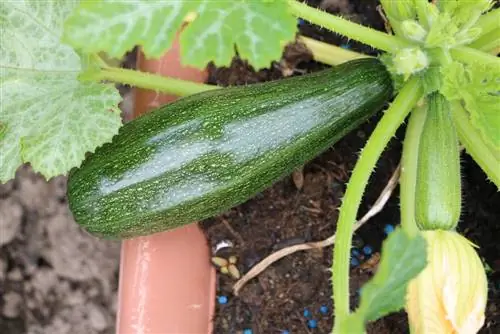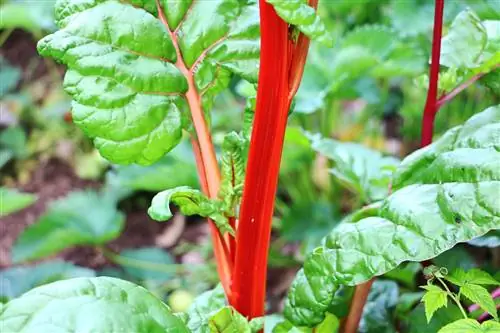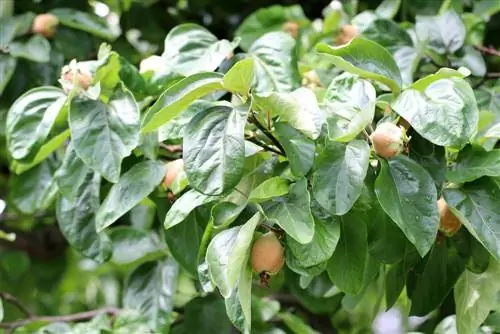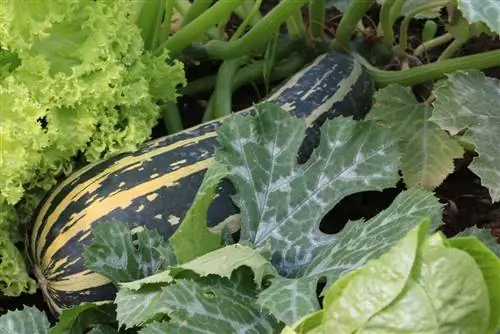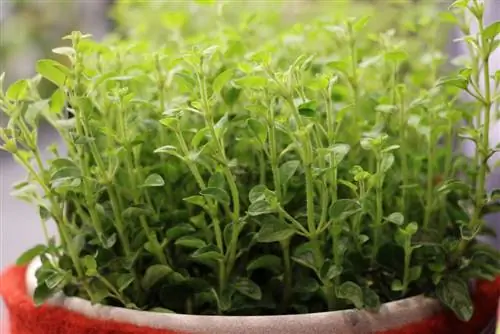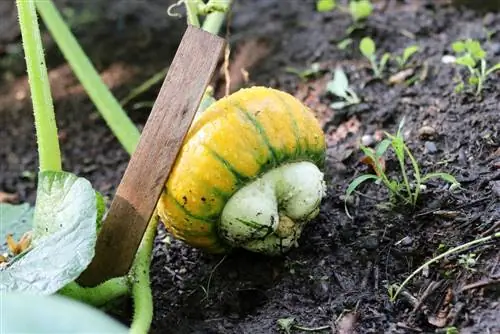- Author admin [email protected].
- Public 2023-12-17 03:39.
- Last modified 2025-01-24 12:45.
Zucchini are pumpkins and are easy to plant even for beginners. These are not exactly easy to care for, but they are grateful and reward with a rich harvest. There are now varieties that are resistant to diseases and are therefore even easier and more promising. It should be rich in nutrients so that the zucchini grow well.
Sunny location is important
Sowing can begin in April in flower pots or in a pre-bed. The seeds can be placed in water overnight. This way the seeds germinate faster because the shell becomes softer. A sunny location is important and stimulates the growth of the plants. After the Ice Saints, planting in the actual bed in the garden can begin. A sunny location is also recommended here, otherwise growth will not progress. Soil rich in humus is preferred. This can also be treated with compost beforehand so that all nutrients can be passed on to the plants.
Zucchini need a lot of space
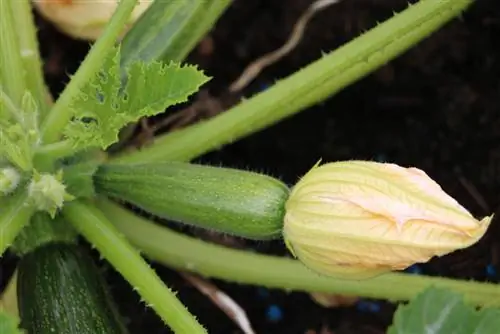
The plants need a lot of space in the bed, so at least 80 cm should be left between the plants. There must be a space of at least one to one and a half square meters between the plants. For smaller gardens, you should choose a variety that can grow up on climbing aids. But bush-shaped zucchini can also be a way to get the delicious vegetables. From now on the plants no longer need much care, apart from regular water and loose soil.
Regular fertilization increases yield
Since zucchini grow quickly, they need a lot of nutrients. Therefore, not only should it be watered regularly, but also fertilized. Mulching can be an option here, as it also keeps weeds away. The soil must also be loosened regularly, as the plants particularly like this. Care should be taken to ensure that no water gets on the leaves, otherwise there is a risk of fungal infection. If watering or fertilizing is not done regularly, the plants can become stressed. This produces more male flowers, which taste delicious but do not bear fruit.
The flowers differ
As a rule, the plant produces the male flowers first. These can be recognized by the elongated and thin stem. These can be harvested and prepared deliciously. The female flowers only grow afterwards and have an ovary. To fertilize the zucchini, just a few of the male flowers are enough. If there are no fruits, fertilization can be done by hand. This often happens when it has been rainy and therefore only a few insects have flown out for pollination. For this purpose, a male flower is simply selected. This is then brought together with the female flower. One male flower can fertilize several female flowers.
The first harvest comes quickly
The first fruits can be harvested after just six to eight weeks. Care must be taken to ensure that the plant does not have too many flowers. Ideally, the fruits are between 10 and 20 centimeters and can then be harvested. Since the plant continues to produce flowers, it is important to remove the fruits, otherwise new zucchini will not be able to grow back. The plant then puts all its power into the existing fruits and not into the flowers. To do this, simply cut off the zucchini. These can be stored in a cool place for about two weeks. Freezing is not possible as they then lose their consistency. However, like cucumbers, these can be preserved in a jar and then eaten later.
Not only people love zucchini
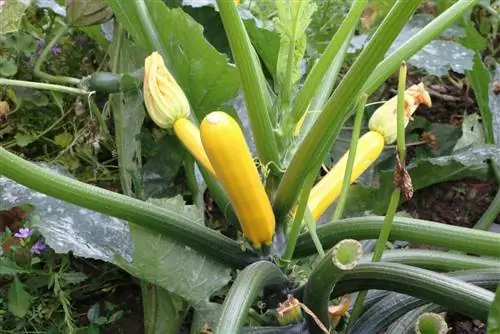
Unfortunately, these fruits also like snails, especially when it is rainy and humid. Therefore, special attention should be paid to these slugs. These can be kept away with a collar or snail fence. If this has been missed, slug pellets can help, or simply collect them by hand. But powdery mildew can also occur in dry conditions. A distinction is made between downy mildew and true mildew. If you have downy mildew, just spraying the leaves with a water mix of whole milk and water helps. Always remove the affected leaves first, even if there is powdery mildew. Here, however, a lecithin mix is sprayed. This can be purchased from garden shops. Fertilizing should be stopped in both cases. Another infestation only occurs at the end of the vegetation phase. This is the mosaic virus and is fatal to the plant. Since this always only happens towards the end of the gestation period, there is no need to treat it here.
A little effort is rewarded
If you pay attention to a few little things, you will have delicious zucchini for a long time. There's not really much to it:
- Choose the right location
- loose up the soil and fertilize
- Growing in flower pots or pre-beds
- Plant in the garden only after the Ice Saints
- Leave plenty of space between and next to the plants
- Water and fertilize regularly
- Remove too many male flowers
- Possibly fertilize by hand
- Also pay attention to pests and diseases
- Remove fruits in good time so that new ones can grow.
If you follow these little rules, you will always have fresh fruit until October. However, flowers should be removed from mid-August. Because now the plant needs all its strength for the existing fruits. Because once the seeds have germinated, the plant exhausts itself. Therefore, fertilization must be carried out constantly and at regular intervals. This means the zucchini can bear fruit and flowers at the same time. The preparation can then be either raw, grilled or cooked. There are no limits to your imagination, especially during gardening time. Because after a little work with the plant, the fruits taste even better. No bought zucchini tastes like your own grown ones.
Care tips and usage
Requires a lot of heat, so ideal to plant on the compost or on black perforated foil. The foil increases the floor heat. The cultivation is similar to that of cucumbers. Zucchini can be grown indoors around mid-April. Zucchini have male and female flowers. Only the female flowers produce fruit. Male and female flowers must bloom together (at the same time) or there will be no fruit. If necessary, dust by hand with a brush or similar.
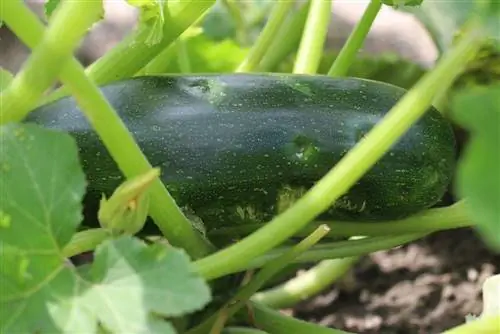
The yield increases with regular harvesting. Feel free to harvest smaller fruits as they are particularly tender and tasty. Zucchini doesn't get along with itself, so don't plant it in the same spot twice in a row. The ideal pre-culture is spinach. Borage, basil, beans, sweet corn, spinach, nasturtiums, radishes, beets and onions, to name just a few, are suitable for mixed cultivation.
Cucumbers, tomatoes, radishes, or potatoes are not suitable for mixed cultivation with zucchini. Zucchini are rich in vitamins A, B1, B2, C and E. The fruits also contain folic acid, zinc, selenium, magnesium, calcium, phosphorus, manganese and potassium. Bitter substances and mucilage are also contained. Zucchini can be stored in the vegetable compartment for a good 14 days. Do not store without refrigeration, as this will make the fruit bitter. Zucchini are suitable for many types of preparation, such as frying, plain or breaded, or for raw vegetable salads, but also for soups. Slightly larger fruits are more suitable for soups.

